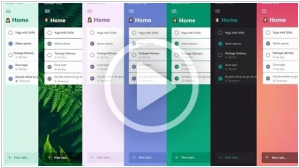Outlook vs iCloud Mail
September 14, 2023 | Author: Adam Levine
37

Microsoft Outlook is a personal information manager from Microsoft. It can be used as a stand-alone service/application, or can work with Microsoft Exchange Server and Microsoft SharePoint Server for multiple users in an organization, such as shared mailboxes and calendars, Exchange public folders, SharePoint lists and meeting schedules.
11
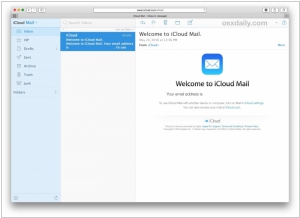
With your iCloud Mail account, you can send, receive, and organize email. When you set up your devices for iCloud Mail, you can also access your iCloud Mail account using the Mail app on your iOS device, iPadOS device, or Mac computer, or using Microsoft Outlook on a Windows computer. No matter which device you use, the changes are updated everywhere.
See also:
Top 10 Email services for Business
Top 10 Email services for Business
Outlook and iCloud Mail are both email services, but they are offered by different providers and have some key differences in terms of hosting, platform support, storage, and integration:
Hosting: Outlook is an email service provided by Microsoft, while iCloud Mail is an email service provided by Apple. This means that the email data for Outlook is hosted on Microsoft servers, while iCloud Mail data is hosted on Apple's iCloud servers.
Platform Support: Outlook is a cross-platform email service that is available on various platforms, including Windows, macOS, Android, and iOS. It can be accessed through web browsers, desktop clients (such as Microsoft Outlook), and mobile apps (such as Outlook for Android and Outlook for iOS).
iCloud Mail, on the other hand, is primarily designed for Apple's ecosystem and is tightly integrated with Apple's Mail app on macOS, iOS, and watchOS. It can also be accessed through web browsers on other platforms, but it may not have the same level of integration and functionality as it does within the Apple ecosystem.
Storage: Both Outlook and iCloud Mail provide storage for emails, but they may have different storage limits and policies. Outlook, for example, offers different storage limits depending on the type of account (e.g., free Outlook.com account, Office 365 subscription, etc.), with options for additional storage upgrades. iCloud Mail, on the other hand, is part of Apple's iCloud storage service, which provides a limited amount of free storage (5 GB as of 2023) that is shared among all iCloud services, including email, photos, documents, and more. Additional storage can be purchased through Apple's iCloud storage plans.
Integration: Outlook and iCloud Mail may have different levels of integration with other services and features. Outlook, being part of Microsoft's ecosystem, offers integration with other Microsoft products and services such as Microsoft Office, OneDrive, and Skype. It also supports integration with third-party email clients and plugins.
iCloud Mail, on the other hand, is more tightly integrated with Apple's ecosystem, with seamless integration with Apple's Mail app on macOS, iOS, and watchOS, as well as other Apple services such as iCloud Contacts, iCloud Calendar, and iCloud Keychain.
In summary, the main differences between Outlook and iCloud Mail are hosting, platform support, storage, and integration. Outlook is a cross-platform email service provided by Microsoft, while iCloud Mail is primarily designed for Apple's ecosystem and is tightly integrated with Apple's Mail app and other iCloud services. Users should consider their specific needs, devices, and ecosystem preferences when choosing between the two email services.
See also: Top 10 Email services
Hosting: Outlook is an email service provided by Microsoft, while iCloud Mail is an email service provided by Apple. This means that the email data for Outlook is hosted on Microsoft servers, while iCloud Mail data is hosted on Apple's iCloud servers.
Platform Support: Outlook is a cross-platform email service that is available on various platforms, including Windows, macOS, Android, and iOS. It can be accessed through web browsers, desktop clients (such as Microsoft Outlook), and mobile apps (such as Outlook for Android and Outlook for iOS).
iCloud Mail, on the other hand, is primarily designed for Apple's ecosystem and is tightly integrated with Apple's Mail app on macOS, iOS, and watchOS. It can also be accessed through web browsers on other platforms, but it may not have the same level of integration and functionality as it does within the Apple ecosystem.
Storage: Both Outlook and iCloud Mail provide storage for emails, but they may have different storage limits and policies. Outlook, for example, offers different storage limits depending on the type of account (e.g., free Outlook.com account, Office 365 subscription, etc.), with options for additional storage upgrades. iCloud Mail, on the other hand, is part of Apple's iCloud storage service, which provides a limited amount of free storage (5 GB as of 2023) that is shared among all iCloud services, including email, photos, documents, and more. Additional storage can be purchased through Apple's iCloud storage plans.
Integration: Outlook and iCloud Mail may have different levels of integration with other services and features. Outlook, being part of Microsoft's ecosystem, offers integration with other Microsoft products and services such as Microsoft Office, OneDrive, and Skype. It also supports integration with third-party email clients and plugins.
iCloud Mail, on the other hand, is more tightly integrated with Apple's ecosystem, with seamless integration with Apple's Mail app on macOS, iOS, and watchOS, as well as other Apple services such as iCloud Contacts, iCloud Calendar, and iCloud Keychain.
In summary, the main differences between Outlook and iCloud Mail are hosting, platform support, storage, and integration. Outlook is a cross-platform email service provided by Microsoft, while iCloud Mail is primarily designed for Apple's ecosystem and is tightly integrated with Apple's Mail app and other iCloud services. Users should consider their specific needs, devices, and ecosystem preferences when choosing between the two email services.
See also: Top 10 Email services
Outlook vs iCloud Mail in our news:
2023. Apple revamps iCloud.com with more features for drive, mail and notes
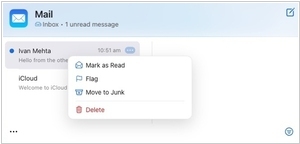
Apple has introduced a revamped version of iCloud.com, enhancing its functionality for PC users. The redesigned website offers support for browser notifications for Mail and Calendar, allowing users to receive alerts directly on their PCs. Additionally, the homepage is now customizable, enabling users to take quick actions like downloading files, deleting emails, marking tasks as unread, and more. This update builds upon last year's redesign, which included quick-glance widgets for apps like Notes and Pages. Furthermore, iCloud.com now enables users to insert links from one note into another, akin to iOS 17, enhancing the overall user experience and productivity on the platform.
2022. The new Outlook client is a collaboration hub
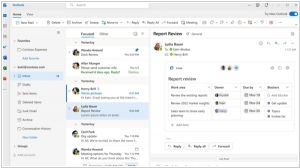
Microsoft has commenced the rollout of the revamped Outlook for Windows, a project that has been in development for over two years. The primary objective of this update was to achieve a unified interface between the Windows program and the web version, Outlook.com, which has been successfully accomplished. The forthcoming Mac version will also adopt the same interface. The new Outlook enables users to view their emails, tasks, and calendar on a single screen, enhancing productivity. It integrates with the new service called Loop, allowing users to send messages to Teams, access files from SharePoint, and collaborate on projects directly within the email body. Furthermore, the updated version offers the ability to quickly convert emails into tasks or events, attach files using @mentions, pin important emails to the top of the list, and seamlessly manage Gmail accounts alongside other email accounts.
2022. Microsoft launches Outlook Lite for low-powered Android phones
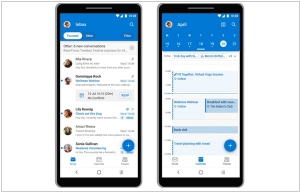
Microsoft has unveiled the lightweight Outlook Lite Android app, designed specifically for low-end Android devices and areas with limited data connectivity. This app has a compact download size of less than 5MB, in contrast to the regular version that can exceed 80MB depending on the device. Currently, the app is only accessible in certain countries, although Microsoft has expressed intentions to expand its availability to additional regions in the future. In June, the company included this app in its Office 365 roadmap, indicating a potential wider release. With Outlook Lite, users can conveniently access their emails, calendars, and contacts for various account types such as Outlook.com, Hotmail, Live, MSN, Microsoft 365, and Microsoft Exchange Online.
2020. Microsoft Outlook is getting text predictions, 2 years after Gmail
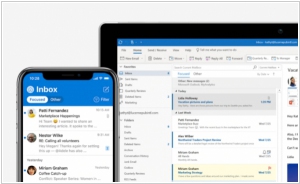
Microsoft's Outlook is introducing a new functionality that offers word and phrase suggestions while composing messages, making email autocompletion effortless for users. This feature will be available on both Outlook.com and Outlook on the web. As you compose an email, Outlook may present text suggestions, which can be accepted by pressing the Tab key or the right arrow key. If you prefer to disregard the suggestion, simply continue typing. Users will also have the option to disable text predictions by navigating to Settings – View all Outlook settings – Mail – Compose and reply. Under Text predictions, you can uncheck the "Suggest words or phrases as I type" box.
2019. Microsoft integrated its personal organizer app To-Do with Outlook
Microsoft has recently unveiled an updated version of its Microsoft To-Do personal organizer. This new release introduces a range of exciting features, including the ability to fully customize the color scheme and background. Additionally, users now have the option to enable 2-factor authorization for enhanced security. The updated Microsoft To-Do also offers smart recommendations to help users create their task lists for the day efficiently. Furthermore, the integration with Outlook has been seamlessly implemented, allowing the Flagged Email list in the app to display flagged messages from Outlook.com. The integration extends further to include Microsoft Planner, a project management service, as well as voice assistants Alexa and Cortana. Notably, Microsoft hinted at the potential closure of Wunderlist, a service acquired by Microsoft four years ago, which served as the foundation for the development of Microsoft To-Do. Following this, the founder of Wunderlist, Christian Reber, publicly expressed his desire for Microsoft to repurchase the service and transform it into an open-source product via a tweet.
2017. Outlook.com gets LinkedIn integration
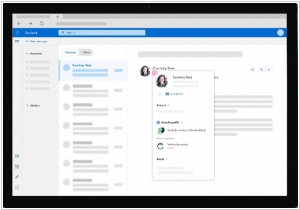
The integration of LinkedIn within Outlook.com is now being rolled out, enabling users of the email platform to access valuable insights, profile pictures, work history, and more directly within their inbox. This isn't the first instance of LinkedIn data being incorporated into email services. Prior to its acquisition by Microsoft, LinkedIn itself acquired a smaller company called Rapportive, which had developed a popular Gmail add-in that integrated social profile information into Gmail's web application. The add-in was later reimagined to focus primarily on LinkedIn integration, rather than connections to other platforms like Facebook and Twitter. With the new integration in Outlook, customers can simply click on the name of an email contact within their inbox to instantly access a comprehensive contact card, complete with a link to their LinkedIn profile.
2017. Microsoft launched faster and smarter Outlook.com
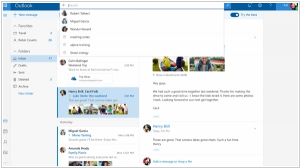
Microsoft has recently introduced a revamped version of Outlook.com, offering an enhanced and faster search interface along with several additional features. One notable addition is a conversation-style inbox, which facilitates easier tracking of longer message threads and previous correspondence. This update addresses the perception of Outlook as a traditional and outdated email service compared to its alternatives. Another noteworthy feature is Quick Suggestions, which automatically displays nearby locations of restaurants or bars mentioned in emails. For instance, if you're planning to meet a friend for drinks, the email will suggest the closest location of that establishment. Microsoft also aims to provide users with a personalized email experience. The ability to mark contacts and folders as favorites has been introduced, allowing for easier retrieval during searches. These improvements enhance the overall functionality and convenience of Outlook.com.
2017. Mobile Outlook gets much smarter search
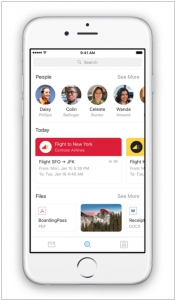
Microsoft has introduced an enhanced edition of its popular Outlook mobile application for iOS and Android. Notably, this version incorporates a smarter search feature, powered by Microsoft Graph, and brings changes to navigation and conversations. With the utilization of Microsoft Graph, Outlook's search functionality is transformed into a comprehensive tool that goes beyond emails. It now includes contacts, attachments, flight and travel details, package deliveries, and more. The new version of Outlook emphasizes search as a central aspect of the user experience. When accessing the search function, users are presented with proactive suggestions for top contacts, recent files, and relevant information for the day, such as travel plans, even before initiating the search. Additionally, auto-complete suggestions prioritize frequently contacted recipients as you type.
2016. Office 365 gets its own built-in lightweight CRM
Microsoft has introduced a new tool, called Outlook Customer Manager, designed specifically for business owners utilizing Office 365 and Outlook. This lightweight CRM solution caters to companies seeking to track customer interactions and history, yet may not be ready for a more robust platform like Dynamics 365. With Outlook Customer Manager, businesses can conveniently monitor ongoing tasks and deals directly within Outlook. The tool includes pop-up reminders to assist users in effectively managing their customer relationships. Once activated, Outlook Customer Manager automatically organizes customer-related information, encompassing emails, meetings, calls, notes, files, tasks, deals, and deadlines. This data, derived from email, calendar, and call log data sources, is presented in a timeline format alongside the inbox. Users have the ability to associate specific tasks with contacts, companies, or deals, enabling them to engage with customers promptly. Additionally, the tool can present lists of deals categorized by stage, close dates, priority, and amount, facilitating efficient deal management.
2016. Mobile Outlook gets built-in meeting scheduler
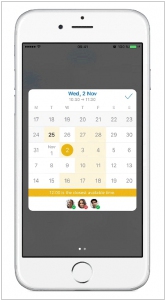
Mobile Outlook has introduced a new scheduling assistant feature designed to facilitate finding a suitable time for everyone involved. This feature, now available in the iOS version of Outlook's mobile app, displays the availability of your coworkers, enabling you to effortlessly select a date and time that accommodates everyone's schedules. To utilize the scheduling assistant, you simply create an event using the app's built-in calendar and add your coworkers to the People field. When selecting the date, the app will automatically present color-coded suggestions, indicating the most optimal times for the meeting based on availability.


